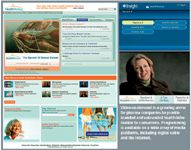Alternative Media: Health on Demand
80 percent of Web users search for health information online to make better health choices.
As broadband-internet connections and digital-cable services become household mainstays, on-demand video is becoming a viable tool for consumers seeking medical information. Forward-looking pharma companies are discovering that by harnessing this new technology, they can provide custom-tailored media direct to consumers.

Raj Amin
Now more than ever, people are proactively seeking drug and health information relevant to themselves and their family members. According to a recent study by the Pew Internet and American Life Project, 80 percent of US Web users search for health information online to help them make better health choices. In addition, nearly 25 million Americans have access to cable video-on-demand (VOD) through their local digital-cable provider. Both media provide immediate access to the latest video programming, delivered to consumers' screens in seconds.

Tony Estrella
The broad availability of high-speed access, the population's general familiarity with the Internet, and the need for new information have turned the tide for e-health strategies, and introduced targeted video strategies.
There are lots of technologies using video-on-demand, from streaming video to podcasting. But lets start by looking at the two basic categories: video that arrives via digital-cable TV systems and video that is available on the Internet. Each technology can host a variety of programming, including long- and short-form health-education videos and infomercial-style advertising.

Cable on demand People turn to television for most of their information. So, to be able to deliver a targeted message right to a living room is a very valuable way to connect with consumers. Cable companies have supplemented their movie, concert, and sports-event paid offerings with a wide variety of free and paid VOD programming, including sample TV shows, broadcast music lessons, and health programming. Viewers select a show from a list of available content and the show starts with a click of the remote.

For marketers, the best part is that cable VOD, in most situations, works based on a partnership model. Programming is given to the cable company for free, and in exchange, the pharma company can post a short ad or sponsorship logo on the video. To help provide content to all the different cable providers, pharma companies can hire a national programming network to act as a conduit to the cable industry.
Internet video Broadband video, as a consumer platform, has come a long way since the days of hour-long download screens. With better streaming technology and higher quality video, the small grainy video box has given way to a richer viewing experience that can be as good as high-definition TV. Video content is searchable through popular search engines like Google and Yahoo, as well as content-specific Web sites tailored to a particular disease state. For further interactivity, programming can drive traffic to other sites for product information. Advertising technology on the Internet also is more advanced, allowing marketers to post banner and video ads on the video screen.

Pfizer took advantage of the Internet video medium when it launched its unbranded heart disease and high cholesterol campaign, My Heart Kit. In addition to a free educational package and interactive Web site, the company hired ad agency Unit 7 to produce a half-hour health education program for television. After its initial airing, the video was tailored down to a series of two-minute VOD shorts that ran on the Internet.
These new media platforms offer consumers more ways to access health information, to be viewed at their convenience. And cable and Internet VOD are just the beginning. Advertisers can harness video podcasts, in-clinic streaming video, TiVo, and cell phone VOD to get their message to consumers. It's only a matter of time before consumers will be turning to the Internet and cable for all their medical education needs.
Raj Amin is president of HealthiNation. He can be reached at raj@healthination.com
Tony Estrella is vice president of medical affairs at HealthiNation. He can be reached at tony@healthination.com

The Misinformation Maze: Navigating Public Health in the Digital Age
March 11th 2025Jennifer Butler, chief commercial officer of Pleio, discusses misinformation's threat to public health, where patients are turning for trustworthy health information, the industry's pivot to peer-to-patient strategies to educate patients, and more.
Navigating Distrust: Pharma in the Age of Social Media
February 18th 2025Ian Baer, Founder and CEO of Sooth, discusses how the growing distrust in social media will impact industry marketing strategies and the relationships between pharmaceutical companies and the patients they aim to serve. He also explains dark social, how to combat misinformation, closing the trust gap, and more.